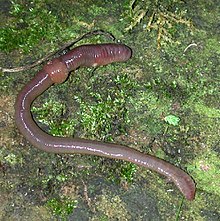Lumbricidae
| Lumbricidae | |
|---|---|

| |
| Lumbricus terrestris, the common European earthworm | |
| Scientific classification | |
| Domain: | Eukaryota |
| Kingdom: | Animalia |
| Phylum: | Annelida |
| Clade: | Pleistoannelida |
| Clade: | Sedentaria |
| Class: | Clitellata |
| Order: | Opisthopora |
| Superfamily: | Lumbricoidea |
| Family: | Lumbricidae Rafinesque-Schmaltz, 1815 |
| Genera | |
|
See text | |
The Lumbricidae are a family of earthworms. About 33 lumbricid species have become naturalized around the world,[1] but the bulk of the species are in the Holarctic region: from Canada (e.g. Bimastos lawrenceae on Vancouver Island) and the United States (e.g. Eisenoides carolinensis, Eisenoides lonnbergi and most Bimastos spp.) and throughout Eurasia to Japan (e.g. Eisenia japonica, E. koreana and Helodrilus hachiojii). An enigmatic species in Tasmania is Eophila eti. Currently, 670 valid species and subspecies in about 42 genera are recognized.[2] This family includes the majority of earthworm species well known in Europe and Asia.
Genera
The family consists of the following genera:
- Allolobophora Eisen, 1874
- Alpodinaridella Mršić, 1987
- Aporrectodea Orley, 1885
- Bimastos Moore, 1893
- Castellodrilus Qiu & Bouché, 1998 stat. nov.[3]
- Cataladrilus Qiu & Bouché, 1998
- Cernosvitovia Omodeo, 1956
- Creinella Mršić, 1986
- Dendrobaena Eisen, 1874
- Eisenia Malm, 1877
- Eiseniella Michaelsen, 1900
- Eiseniona Omodeo, 1956
- Eophila Rosa, 1893
- Ethnodrilus Bouché, 1972
- Eumenescolex Qiu & Bouché, 1998
- Fitzingeria Zicsi, 1978
- Flabellodrilus Gérard, Decaëns & Marchán in Gérard et al., 2023
- Gatesona Qiu & Bouché, 1998
- Healyella Omodeo & Rota, 1989
- Helodrilus Hoffmeister, 1845
- Heraclescolex Qiu & Bouché, 1998
- Iberoscolex Qiu & Bouché, 1998
- Imetescolex Szederjesi, Marchán & Csuzdi In Szederjesi et al., 2022
- Italobalkaniona Mršić & Šapkarev, 1988
- Kenleenus Qiu & Bouché, 1998
- Kritodrilus Dumnicka, 1983
- Lumbricus Linnaeus, 1758
- Meroandriella Mršić, 1987
- Octodriloides Zicsi, 1986
- Octodrilus Omodeo, 1956
- Octolasion Örley, 1885
- Octolasium Michaelsen, 1900
- Omilurus Templeton, 1836
- Orodrilus Bouché, 1972
- Perelia Easton, 1983
- Philomontanus Bozorgi, Seiedy, Malek, Aira, Pérez-Losada & Domínguez, 2019
- Pietromodeona Qiu & Bouché, 1998
- Postandrilus Qiu & Bouché, 1998
- Proctodrilus Zicsi, 1985
- Prosellodrilus Bouché, 1972
- Reynoldsia Qiu & Bouché, 1998
- Satchellius Gates, 1975
- Scherotheca Bouché, 1972
- Spermophorodrilus Bouché, 1975
- Tetragonurus Eisen, 1874
- Zophoscolex Qiu & Bouché, 1998
Range
The worms in the family Lumbricidae originate from Europe, but over time members of the family have since been introduced and spread around the globe.[4]
Europe
Members of Lumbricidae are native to Europe and are most diverse in southern Europe.[4] There are 30 species from the family in Ireland and Britain. Notably, a single mature individual of the species Prosellodrilus amplisetosus was found in a survey of soil biodiversity in Ireland. P. amplisetosis had never been recorded in Ireland before and is commonly found in France or Spain. It is thought to have been introduced by humans through agricultural supplies.[5] Another interesting case is of the species Dendrobaena attemsi in Scandinavia. They were first found in a national park in Sweden, the furthest north the species have been found. The discovery of D. attemsi implies the range of the species is increasing north.[6] It is not only in Sweden that species of Lumbricidae are expanding their range. Many of the species found in Finland are exhibiting similar increases in range[7] and Lumbricidae worms are also expanding into Northeastern Europe, starting from the near Baltic sea.[8]
A 2022 molecular phylogenetic study of the highly diverse Franco-Iberian genus Zophoscolex showed most of the Iberian species to form a distinct clade, formally described as Castellodrilus stat. nov..[3] Other species were moved to the genera Cataladrilus and Compostelandrilus, with the remaining species remaining in Zophoscolex restricted to French representatives.[3]
Asia
Lumbricidae make up the majority of earthworms found in China, despite not being native to the area.[4]
At higher elevations in India, some species of Lumbicidae can be found.[4]
North America
When European settlers came to North America, so did European earthworms like the Lumbricidae. Before this, the area in North America where glaciers had been were mostly worm-free.[9] Lumbricidae worms are known to be expanding into the Great Lakes region.[8] The introduced worms have an impact on the native species and environments. Species from the family, such as Lumbricus rubelles, are believed to have displaced the local species in a number of regions.[10] In others, Lumbricidae species outnumber the native species in terms of biomass. Despite this, they are not as productive, in terms of processing nitrogen and phosphorus, as the native species.[11] Lumbricidae worms also tend to have a higher species richness than native North American worms, though the species richness of both the native and Lumbricidae decreases with increasing latitudes.[12]
New Zealand and Australia
Similar to North America, worms from the family were introduced to New Zealand and Australia by European settlers.[13][4]
Predators
References
- ^ "Contents of "Cosmopolitan Earthworms" 1st and 2nd Editions, Blakemore (2002, 2006)". VermEcology. 2008-02-12. Archived from the original on 2008-12-16.
- ^ "A Series of Searchable Texts on Earthworm Biodiversity, Ecology and Systematics from Various Regions of the World". YNU, COE Chapter 10: A list of valid, invalid and synonymous names of Criodriloidea and Lumbricoidea (Annelida: Oligochaeta: Criodrilidae, Sparganophilidae, Ailoscolecidae, Hormogastridae, Lumbricidae, Lutodrilidae). 2007. Archived from the original on 2008-01-05. Retrieved 2008-01-04.
- ^ .
- ^ JSTOR 30245178.
- JSTOR 24393865.
- JSTOR 23735685.
- JSTOR 23734486.
- ^ ISBN 978-1-4020-5429-7.
- JSTOR 30245178– via JSTOR.
- S2CID 84508255.
- ^ James, Samuel (Dec 1991). "Soil, Nitrogen, Phosphorus, and Organic Matter Processing by Earthworms in Tallgrass Prairie". Ecological Society of America. 72: 2101–2109 – via JSTOR.
- JSTOR 20172050.
- JSTOR 26198802.
- S2CID 90842034.
- S2CID 84992833.
External links
- Earthworm Society of Britain – information on British earthworms
